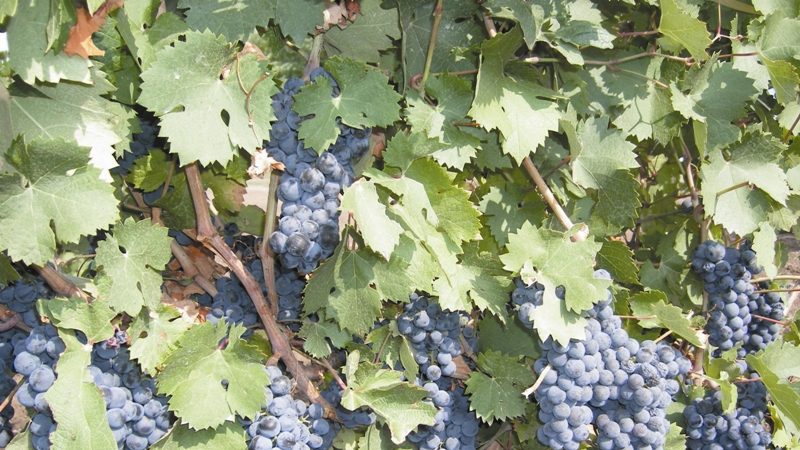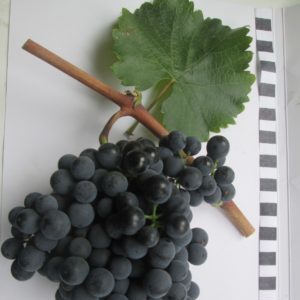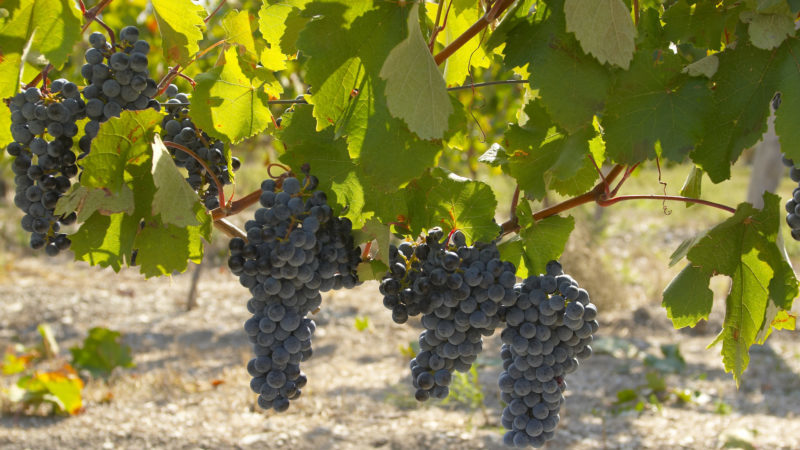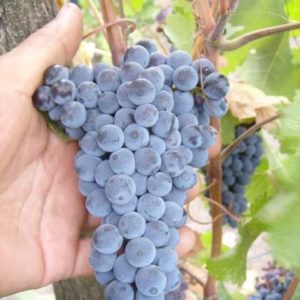Popular Russian grape variety "Krasnostop"
Krasnostop is a grape variety for technical purposes, widespread in the Rostov Region and Krasnodar Territory.
The berries of Krasnostop Zolotovsky have a deep, dark blue color and are distinguished by a high sugar content, which makes it possible to obtain from them a ruby-red wine with purple and violet highlights.
The content of the article
History of the origin of Krasnostop grapes

There are several theories of the origin of the Krasnostop Zolotovsky grape variety. The first is associated with the Don Cossacks and the European variety Cabernet Sauvignon. Her followers claim that the first seedlings appeared on the Don in 1812. The Cossacks liked him so much that they did not miss the opportunity to bring several cuttings to their homeland.
Don Cossacks called the vine "foot", and the Krasnostop variety has a red comb, hence the name. The academic reference book "Ampelography of the USSR" for 1954 mentions the presence of grapes in the nearby areas of the village of Starozolotovskaya. Hence the second part of the variety name.
The second theory of the origin of grapes is associated with the Cossacks and the Caucasus. Its followers are sure that the variety has Dagestan roots and was introduced in the VIII century. from the territories of modern Dagestan. The author of the theory is the famous Russian winegrower A.I. Potapenko. The scientist conducted a number of studies and found that the Don viticulture has not three hundred years, but a thousand-year history and goes back to the times of Khazaria.
Potapenko describes the external characteristics of the Don varieties and draws attention to their relationship with Caucasian cultures. For example, the Dagestan variety Gimra and Donskoy Krasnostop have practically no differences. The leaf blade of both plants is reticulate-wrinkled leaves with a glossy sheen. Large leaves with sharp teeth, contrasting with small leaves with blunt teeth. The berries are dark blue, almost black, round in shape. Sugar content is high. The differences concern flowers: in Gimra they are female, in Krasnostop they are bisexual.
Followers of the third theory consider Krasnostop to be an autochthonous variety. In 2013, the Swiss ampelograph Jose Vuaymo studied three Don varieties - Krasnostop Zolotovsky, Sibirkovy, Tsimlyansky black. The scientist compared their DNA with a database of profiles of more than 2000 world varieties and found no coincidence. Based on this, Vuaymo came to the conclusion that the Don varieties are aboriginal.
Variety characteristics
Krasnostop Zolotovsky - a technical variety of medium ripening... It is included in the ecological-geographical group of varieties of the Black Sea basin. The culture is zoned in the Rostov region and Krasnodar region (Anapa). The ripening period from the moment of budding is 136 days, provided that the average temperature is + 25 ° C.

The bushes are characterized by moderate vigor. The vine ripens completely. The leaves are small or medium, soft, rounded, flat or funnel-shaped, with five or three lobes. The middle blade is wide and obtuse. The surface of the sheet plate is glossy, finely reticulate and wrinkled. The back of the leaf is covered with a dense cobweb-like cannon with fine bristles. The petiole and central veins are wine-red.
The upper notches are medium or deep, closed, with ovoid or oval openings. The lower notches are weak, angular, open, less often closed with gaps.
The teeth along the edges are small, triangular-saw-shaped and dome-shaped.The flowers are bisexual. The clusters are medium, conical, 8-15 cm long. The largest ones have small lobes at the base, medium-dense or loose.
The berries are round, small and slightly oval, weighing 0.8-1.2 g. The color is dark blue, with a blue waxy bloom. The thickness of the skin is medium, the pulp is juicy.
The sugar content of the berries is 25-27%. The acidity is high - 4.9-9.0 g / l, but decreases as the berries ripen. Harvesting is often delayed for this very reason - they wait until the berries are fully ripe or overripe. From such grapes, sweet red wines with a cherry aroma and a material for blending red sparkling wines are obtained. When harvested early, red table wines with a harmonious taste are obtained.

Zoning
The main plantings of Krasnostop are located in the Konstantinovsky district, the Razdorsky district of the Rostov region. The vineyard area is small. Some bushes are scattered in an inhomogeneous mixture with other varieties. Krasnostop does not grow outside the Rostov region and Krasnodar Territory.
Sustainability
Krasnostop is characterized by average resistance to frost, however, when freezing, it quickly recovers in spring. The uniqueness of the variety is the ability to self-renew.
The plant is resistant to drought, but in a prolonged period of lack of natural moisture it needs additional watering and sprinkling.
Resistance to powdery mildew and mildew is above average, but when the rules of care are violated, the protective forces of the grapes are reduced.
Interesting. Winegrowers note the fungus Botrytis Cinarea and call it the "noble fungus". Unlike pathogens, it does not reduce yields and does not harm. Experts believe it has a positive effect on the taste of wine - similar to cheese.
Flowering and ripening period
In the steppe vineyards of the Lower Don region, the buds bloom at the end of April, flowering occurs at the end of the first decade of June, the berries ripen until August 10. Full maturity occurs on September 13-15.
Yield

The yield of Krasnostop is average, depending on the place of growth and soil moisture. Loose, small, underweight brushes (50-60 g each) are formed on dry soil. On wet soils, clusters are heavy, large, weighing 100-150 g, the yield is high. On average, 60-80 centners are harvested from 1 hectare.
Advantages and disadvantages
The advantages of the variety:
- high sugar content;
- the possibility of obtaining semi-dessert and table wines;
- the ability to self-renew;
- resistance to mildew and oidium;
- high productivity.
Disadvantages:
- dependence of yield and taste on the place of growth and soil moisture;
- decreased immunity with improper care.
Wine from the Krasnostop Zolotovsky variety
The grapes grow on their own roots. Its not inoculate on an American stock for protection against phylloxera, therefore the variety is considered authentic. Bushes grow using traditional agricultural technology - the vine is buried for the winter to protect it from frost.
The grapes are used for the production of semi-sweet and semi-sweet table wines. The drinks are colored deep ruby red with purple highlights. The texture is transparent, oily with a chic shine. The aroma is moderate, with notes of ink, cherry, blackberry, prune, licorice, vanilla, menthol.
The taste is full-bodied, tannic, moderately fresh with hints of leather, cherry, mulberry, tobacco, rye bread crust, vanilla and light smoked meats. The aftertaste is long-lasting, with blackberry and blackcurrant tones. Wine is served with beef steaks, rack of lamb, hard and soft cheeses.
Dry red wine has a ruby color with purple highlights. The texture is transparent, oily, with shine. The aroma is intense with notes of blackberry, currant jam, plum, cloves and light creamy aftertaste. The taste is full-bodied, tannic, moderately fresh with notes of dried cherry, prune, mulberry and spices. Long-lasting aftertaste with blackberry and blackcurrant tones. The drink is served with prosciutto, beef steaks with black pepper, rack of lamb with prunes.
The alcohol content in wines is 14.5% vol. Serving temperature - 17-18 ° С.
Reference. In November 2013, wine from the Krasnostop Zolotovsky variety was presented at the World Wine Simposium on Lake Como, Italy. World experts appreciated the taste of the drink presented by Jose Vuaymo.
Wines from the Krasnostop variety have received high marks from international wine critics: Steven Spurier, Robert Joseph, Oz Clark.
Planting seedlings
It is important to choose a location before planting grapes. The site should be located on the southern or eastern side, the occurrence of groundwater is required low, the sun illumination is comprehensive.
Two weeks before planting, the soil is dug up and fertilized with manure, compost and superphosphate. This rule applies to nutrient-poor areas. Fertile black soil does not need additional fertilization.
Experienced growers recommend planting seedlings in the autumn. They are purchased in specialized nurseries and taken from existing bushes.
Cuttings preparation rules:
- Cuttings are harvested after leaf fall before the first frost.
- The vine should be of an even color, crackle when bent, the core should be dense.
- Cuttings are taken from the branches of the current year, with 4-6 developed buds, 50 cm long, 5-7 mm in diameter.
The cuttings are stored in wet sawdust or plastic bottles in a refrigerator at a temperature of 0 ... + 4 ° C. They are checked once a month. If mold appears, wash in a dark solution of potassium permanganate.
In the spring, the cuttings are checked for viability - a cut is made at the ends. If moisture has come out, it means that they are ready for planting, if not, they are dry. If liquid oozes, the cuttings are rotten. The cut should be light green, without dark blotches.
On each viable cutting, shallow grooves are made and immersed in clean water at room temperature and changed 3-4 times within 24 hours. Then the cuttings are placed in a jar of water and wait for the roots to appear.
On the site, holes of 80x80 cm are formed, crushed stone or broken brick is placed on the bottom. Fertile soil mixed with 1 kg of humus, 200 g of superphosphate, 1 liter of wood ash is poured on top, and poured with settled water.
A pipe for irrigation is dug in the center of the pit. Then a layer of clean soil without fertilizers is added and the cutting is placed. The roots are straightened, the hole is filled to the brim with fertile soil and watered. A distance of 1-1.2 m is observed between seedlings. The row spacing is 1.5-2 m, the gap between the vine and the fence is 0.5 m.
The nuances of care
Krasnostop grapes need moderate watering at the beginning of growth and development, and abundant watering during dry periods. The plant reacts gratefully to sprinkling.
After each watering, the earth crust is loosened to ensure the flow of oxygen to the root system.
In the spring, nitrogen is introduced to increase the sugar content of the berries, if necessary (solution of chicken manure 1:20).
Two weeks before flowering, the bushes are irrigated with a solution of sodium humate (4 g per 10 l of water). Two weeks after flowering - with a solution: 4 g of sodium humate, 5 g of boric acid per 10 liters of water.
Pruning bushes performed in the spring: to form a strong vine, increase frost resistance and yield. Pruning in the first year of life stimulates the vines to grow rapidly. The procedure is carried out before the start of sap flow.
In the fall, the ripe lower vine is cut into a twig, the upper one - by 5-10 buds. In spring, the bushes are inspected and dry and damaged branches are removed.
Bushes cover for the winter trenching method. This allows you to protect the roots from freezing. The depth of the trench is 30 cm. The walls are reinforced with boards. The branches are tied with twine and placed in a recess, 50 cm of earth is poured on top and harbor polyethylene. The ends are reinforced with bricks.
Disease and pest control
For the prevention of mildew and oidium, prophylactic treatment with "Ridomil", Bordeaux liquid, colloidal sulfur is carried out. For treatment, a sulfur solution is used - 100 g per 10 liters of water. Processing is carried out in the evening or in cloudy weather 3-5 times with an interval of 10 days.
Vine bushes most often affect the caterpillars of the grape leafworm. For their destruction use insecticides: "Fury", "Talstar", "Angio 247", and biological products "Fitoverm", "Lepidocid", "Bitoxibacillin".
To kill ticks, insecticides are used: "Fufanon", "Neoron", "Aktellik".
Harvesting and storage
Harvesting begins in early August and ends in mid-September, depending on the destination of the berries.
Industrial grapes are not stored, but immediately sent for processing.
Conclusion
Krasnostop Zolotovsky grape is an authentic technical variety used for the production of semi-sweet and dry red wines with cherry, blackcurrant, blackberry flavors and aromas. The culture is characterized by an average level of winter hardiness and requires shelter for the winter.
Subject to the rules of agricultural technology, it shows resistance to mildew and powdery mildew, in adverse conditions it needs preventive treatment with "Ridomil" and solutions of sulfur, colloidal sulfur.